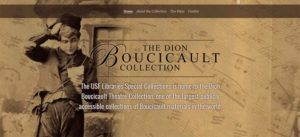Digital Drama
Posted on April 26, 2017 in Digital, Special collectionsWe have not digitized anything in our Irish theatre collections. While we have a great collection of theatre programs and scripts, much of this is in copyright.
But I have been watching with great interest the digital project of the plays of Dion Boucicault at the University of Southern Florida, and the potential it holds for scholars of Irish drama.
The Dion Boucicault Collection at USF Libraries is one of the largest Boucicault collections in the world. Under Matt Knight’s careful stewardship, selected works are displayed and contextualized in a clear and easily-navigated website. The introduction explains that Dublin-born Boucicault was wary of publishing his plays for fear of piracy, and therefore few of his scripts exist in print.
The collection website lists fourteen plays of which ten are currently available on the site. These include The Shaughraun and Robert Emmet. Selecting a play from the menu takes you to an introductory page with brief information on the play and its performance, and links to the digital items, in most cases a promptbook which can be viewed online or downloaded, and a transcript.
 The promptbook for Marriage, for example, is described in the catalog as “typed pages with extensive notes from the stenographer and minor notes from the author”.
The promptbook for Marriage, for example, is described in the catalog as “typed pages with extensive notes from the stenographer and minor notes from the author”.
The Shaughraun section includes the most interesting content, with multiple promptbooks and photographs from various productions of the play.
After exploring the website, I sought more information on USF’s collection and sure enough I found a library finding aid, or archival description, of the Dion Boucicault Theatre Collection 1843-1887. Here we learn that the collection was originally bequeathed by Dion Boucicault to his widow Louise Thorndyke, and was sold a couple of times before being acquired by USF.
The collection consists of 27 boxes, and the finding aid provides a detailed list of contents.
I wish the website had a link to the finding aid and a brief explanation of the scope of the collection, and that the finding aid likewise provided some indication of the digital project. That would be of great assistance to people who stumble on either one.
I hope more collections will be digitized in a similar way, and and I expect to spend much time exploring this website as we learn to use our library’s digital exhibit facility.






